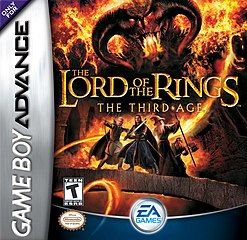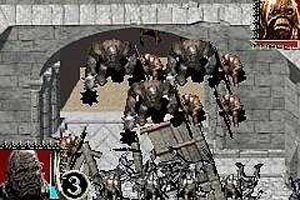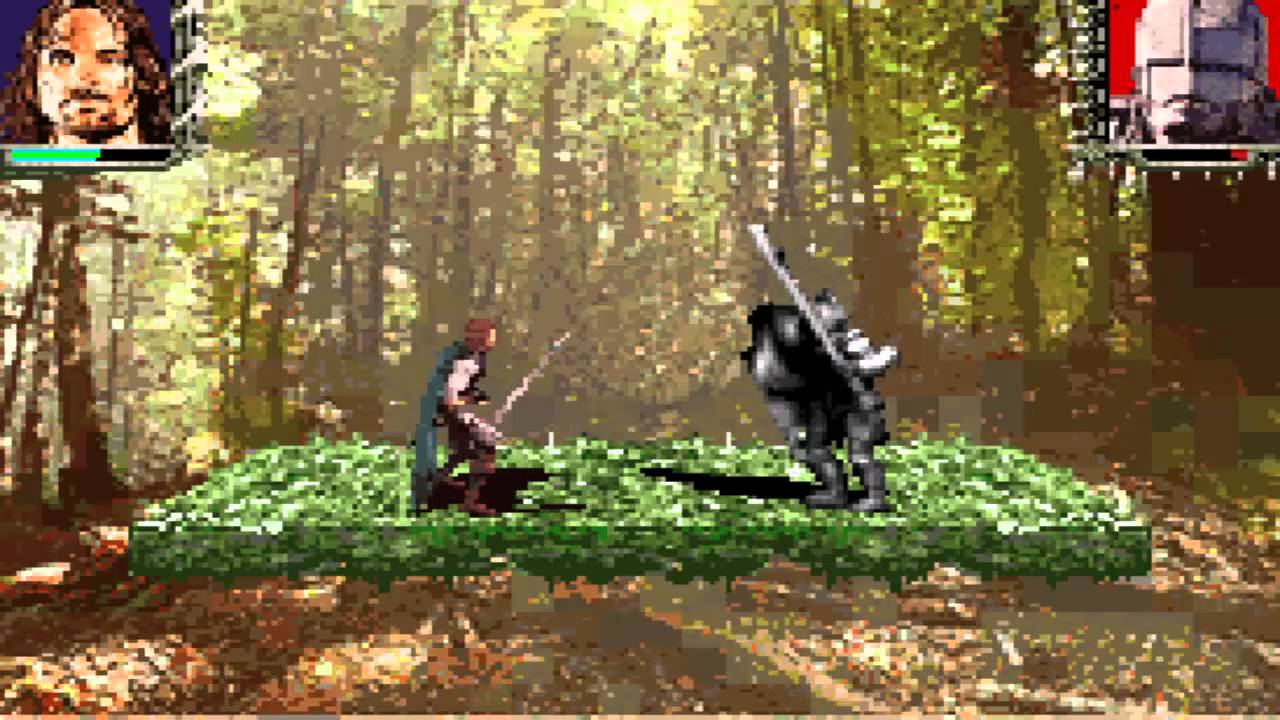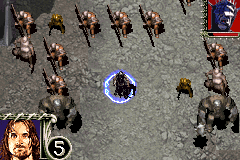The Lord of the Rings: The Third Age - A Cut Apart
16/10/22

It’s funny. I’ve always viewed the GBA as this wonderful cornucopia of strategy, tactical RPGs, but now that I think about it, I’ve really barely scratched the surface. I mean, I played the hell out of games like the GBA Fire Emblem games, Final Fantasy Tactics Advance, or Advance Wars, but there are few others that I’ve played in my childhood that really stick out. Bucking that trend, however, was a rather niche, oft-forgotten title in one of my most beloved franchises ever - The Lord of the Rings: The Third Age, a strategy RPG covering the entirety of Peter Jackson’s incredible Lord of the Rings trilogy. It was, without a doubt, one of the games I played the most as a child on my PC GBA emulator, but it’s been the better part of a decade since I last tried this game - how does it really stack up to its peers?
As you’ve probably remembered from my review of the Two Towers GBA game, I’m a gigantic Lord of the Rings fan, and that went double during my teens. I was obsessed with Lord of the Rings, but I was also obsessed with GBA strategy games like Fire Emblem and Advance Wars - so when I stumbled upon The Third Age in circumstances I don’t quite recall, I was over the moon in excitement. I played this game over and over again - helpful, considering it does have some decent replay value - and ever since then I’ve always held it up as one of my favorite GBA games ever. But, of course, I’m getting ahead of myself - let’s dive into this title, shall we?

At its heart, The Third Age is a turn-based strategy game with light role-playing elements. For each of the game's twenty or so levels, you can choose to play as the ‘Good’ or ‘Evil’ side of the battle, being given a predetermined amount of troops, and being assigned a number of objectives to complete. Each objective will reward victory points, and earning enough victory points will, surprise surprise, earn you victory itself. The twist is, the opposing army also has its own set of objectives, so not only are you trying to get your objectives met, but you’re trying to prevent your opponent from doing the same. For both the purposes of this review, and because I’m an edgy, edgy sod, I played through the ‘Evil’ campaign of the game, using The Mouth of Sauron as my main hero. If that doesn’t describe what kind of person I am, I don’t know what will.
Combat is pretty straight forward - each unit has a predetermined power level, split across physical hand-to-hand combat, and ranged combat. Some units can’t use ranged attacks at all, though this is usually made up by a hand-to-hand rating. Additionally, there are Commander-tier characters who have universally higher stats, and contribute to your Command Points. Command points are basically the amount of times you can move a unit, and a huge part of strategy involves working out which flank you’ll have which heroes on - do you move all of them onto one front, giving you a huge amount of Command Points, but condemning the other flanks to only getting one, or perhaps no moves at all, per turn? Or do you spread your Commanders thin, having a wider command of the battle, but with less velocity in each point? It’s surprisingly insightful, especially considering the unique abilities of Commanders only spread across their own flank.
There is a surprising amount going on in the Third Age, but it really isn’t as complicated as I make it sound. You’ll have armies crashing against one another, and there’s a genuine sense of satisfaction as your troops carve their way through cannon fodder, making their way towards Commanders or objectives.Utilizing your Commanders offensively, too, is consistently delightful, since they just hit so much harder than the normal rank and file troopers. There isn’t any real sense of rock-paper-scissors elements so present in unit-based strategy - it’s much more a matter of setting up lines of troops to block the enemy, and utilizing ranged forces to pepper them from behind. The slight roleplaying mechanics - and I mean slight - come in the fact that your chosen Hero - and the various sub commanders you can use during the campaign - can accumulate XP to learn new abilities or power them up. The stats are fine, but it can be pretty entertaining to play around with some of the abilities - absolutely devastating enemy troops with a powered up Commander never really got old, or throw a couple of extra Command Points into your bank.
The Third Age is also surprisingly a pretty good adaptation of much of The Lord of the Rings, showcasing pretty much every major and minor battle featured in the films, and even some not seen at all - for an example, you can partake in the battle in which Theodred, prince of Rohan, is mortally wounded, or engage in the retaking of Osgiliath by Boromir and Faramir. It does lead to some inconsistency issues - I mean, how the hell is the game going on with Evil winning every battle - but it’s nothing worth worrying about.

Now Command Points… that’s something to worry about.
Moving on from that genuinely terrible segue, Command Points are the source of my biggest gripe with the game - RNG. Whilst a lot of tactical games on the GBA throw RNG into the mix, The Third Age had a more personally frustrating system then most. For each of your three sub-areas, you’ll be given Command Points based on the Commanders in each front. The fact is, you can just be brutalized by RNG here - more than once, I just rolled one or two turns on the area I really needed them, but the foes - with the same amount of Commanders - was rolling 3, 4, sometimes even 5 turns, swarming my troops and not giving me a chance to fight back. This frustration is multiplied by the game’s event system - each turn, each army will get a random buff for that turn, usually just an extra move, but it can give you extra damage, heal your troops, or even give every unit on that front a move for nothing. It’s one of those kinds of mechanics that feel satisfying as all hell when you get it, but feels utterly brutalizing when you’re on the receiving end. I’m sure I”m just salty and that’s clouding my vision, but I swear I only got the ‘Rally’ (getting a ton of moves for nothing) once in my twelve-or-so hour time with the game, at it was on a flank that 100% didn’t need it. To make matters worse, there’s a ‘Disorder’ debuff that can randomly occur, giving one of your flanks ‘0’ moves that turn, and there was more then one instance of this happening to me at a critical stage of a battle - honestly, if RNG doesn’t have your favor, you could lose the advantage right there and then. It’s just genuinely so frustrating that a game has such a solid foundation, but they had to throw more than a dash of frustrating randomness into the mix.
But at the end of the day, it isn’t quite the end of the world; The Third Age is simply that much fun. The first handful of stages are pretty basic, but quickly the difficulty and complexity of the stages ratchet up. Stages that seem simple really feel like they have phases to them, requiring you to solve one, smaller objective before tackling a more rewarding one. For example, one of the best stages in the game is The Fall of Osgiliath. On the Evil side of the battle, you’ll be getting endless troops every turn to storm the fallen city, and your victory condition is to essentially capture every flag. The issue is, Good’s victory condition is simply killing 12 troops. So whilst your goal is to capture those flags, first you need to establish a beachhead, and more importantly, rush down the enemy Commanders - who typically have much higher Command Points output then you - before their moves melt down your generally weaker troops. There’s a surprising amount of depth to engagements in The Third Age, and I was just as delighted with these multi-layered scenarios as I was all those years ago. This comes to a head in the last few battles of the game, where you’re controlling gigantic powerhouses like Cave Trolls or the elephantine Mumakil to devastated your foes - it isn’t easy, but my god, is it entertaining - one shotting with these one-of-a-kind siege units is practically euphoric. Or maybe I’m just weird. Unfortunately, the fact is the game has a difficulty spike around two thirds of the way through, which whilst you can overcome, can be frustrating to tackle when it comes to RNG. There are a few battles, such as The Walls of Minas Tirith or the Assault on Isengard, where the deck is stacked against you frp, the get-go… and then RNG just decides to rear it’s oft-ugly head. You can overcome it, but it makes a few stages far, far more frustrating then they have any right to be.

It’s also not a particularly attractive looking or sounding game, with blobby sprites, both in and out of battle, and the music, whilst being okay renditions of some of Lord of the Ring’s iconic tracks, struggles to not wear thin, especially considering the GBA’s… unique musical qualities. I ultimately decided to play it without sound, listening to podcasts and audiobooks as I played, and it’s fantastic as that sort of ‘background’ game, not being overly complex but still incredibly engaging. I’m not too fussed by the average looks for the game, considering how it scratches a specific strategy itch others in this genre don’t quite hit. It has a decent stock of replay value, too - after you’ve completed one alignment’s campaign, you’ve got the opposite one, too. You also have multiple difficulty modes - no real boosts to AI, just damage numbers, really - and ‘Sauron Mode’, where if you lose a Sub-Commander in the field, they stay dead, and remain unselectable. Considering how much I used Wormtongue, and how he had as much HP as a dying rat, I’m far, far too much of a coward to try Sauron Mode… though, there is a few extra maps to unlock through the difficulty modes, if you want a goal to motivate you!
But I just want to underline the fact that despite all these little issues I had with the game, I had a really, really good time revisiting The Third Age. Strategically leading an army, swarming Legolas with mooks (Fuck Legolas, all my homies hate him in this game), one shotting a hobbit with The Mouth of Sauron, overwhelming an objective chokepoint… There are so many moments I can think of in this game where the problems just don’t matter. It’s a SRPG that has elements familiar to the genre, but takes them in it’s own direction - it’s not remotely perfect, but god, it’s a breath of fresh air to see how far it is from titles like Fire Emblem and Advance Wars - and considering it’s The Lord of the Rings, and a good ass Lord of the Rings game… man, it just helps the problems melt away, you hear?
Which reminds me… which Fire Emblem game should I review first?
Anyway, The Lord of the Rings: The Third Age is a really solid SRPG that stands out from the crowd. It doesn’t succeed at anything, and it’s slight reliance on RNG does cause issues in the long run, but as it is, The Third Age is perfect for the likely large Venn diagram of people crazy about strategy games and The Lord of the Rings - I’m in that too, and I bet I could pick y’all out from a crowd. Like I said - it’s not perfect, not nearly, but it does enough different, as it is a cozy enough experience that I can’t help but urge you all to give it a shot.
Just… fuck Legolas, though. I have nightmares about his goddamn Sweep Attack on the Walls of Minas Tirith. Goddamn hacks, man.
Thank you for reading my review of The Lord of the Rings: The Third Age! It’s good to be getting back into the swing of things with these reviews - honestly, the hard part is just finding the time to review all these fantastic games! Not sure what’s coming next, but in two weeks I’ll be releasing a game befitting the Halloween season - the Game Boy Advance port of Shin Megami Tensei! Seriously, though, there really aren’t that many scary horror games on the GBA, outside of Silent Hill (which I’ve already played) and Metroid Fusion (which will come eventually, but probably on a more celebratory review). So, uh, look forward to that!
As always, you can email me at cckaiju@gmail.com if you have any questions or review requests! Have a good one, and I’ll see you in my next review.
